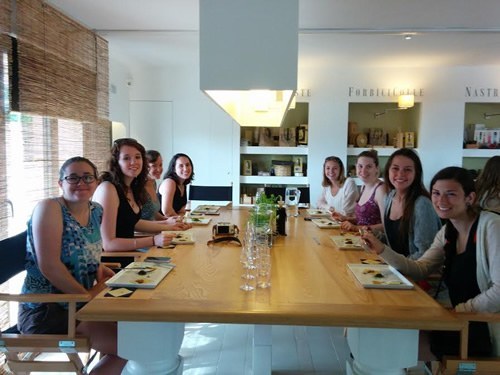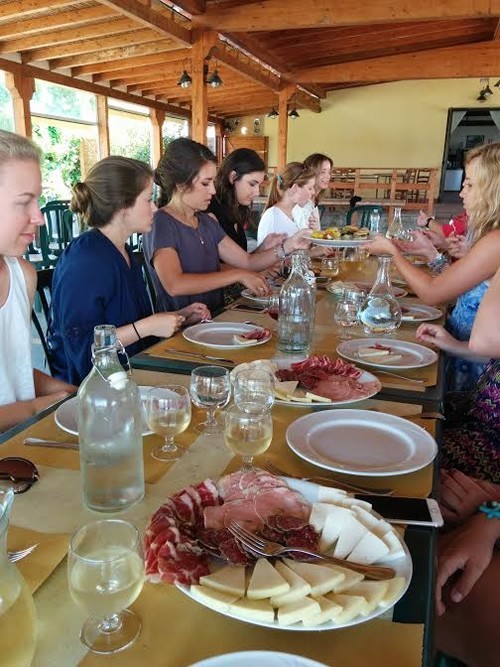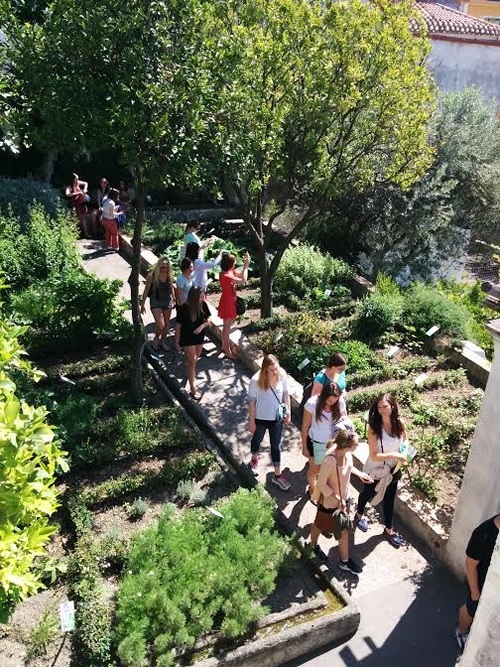|
A Feast for the Food Conscious
Attending Gustolab's "Critical
Studies on Food in Italy Summer Program"
By Maryam Henein
 |
Class dining together. Photo
courtesy of Gustolab.
|
The wandering gypsy/journalist within
me salivated with delight when an announcement for the Gustolab
International Institute’s (GLI) Critical Studies
on Food in Italy Summer Program popped up on the Comfood
Listserv, an email discussion list geared toward a community
of teachers, activists, and food security enthusiasts.
GLI, the first Italian center dedicated to short and long-term
food study, was calling on applicants, degree seeking or
not, to study food, media, communication and trends, nutrition,
and culture.
Since making the award-winning documentary
film Vanishing
of the Bees, I have been studying the food supply
within the context of different countries and cultures.
As I report on how chemicals and additives affect bees and
beings worldwide, I also explore the impact of big food
corporations on the rubric of food cultures. GLI’s 5-week
immersion program, headquartered in Rome, offered a once-in-lifetime
opportunity to combine 3,000 years of culture with a rich
learning opportunity. Bellisimo!
Since its inception 10 years ago, GLI
has already worked collaboratively with more than 14 schools,
including Auburn University in Alabama, the University of
Illinois at Urbana-Champaign, NYU, Hobart and William Smith
Colleges, and the University of Massachusetts Amherst.
"We discuss the influence of politics
on food availability and food practices, as well as the
importance of cross-cultural communications to address nutrition
and cultural issues," explains Director Sonia Massari,
Ph.D.
GLI also designs other programs that
examine food in all its complex and multi-layered perspectives,
including historical, political, economic, cultural, and
culinary.
I was particularly keen on two classes: Food
Media, Communication and Trends, which focuses on
the intersection between food and media and Food,
Nutrition and Culture in Italy, which looks at dietary
practices, with particular emphasis on how Italy compares
to the United States. I was curious to learn how industrialization
had kneaded and shaped Italian society and its food,
and how those changes in culture have affected Italian
dietary practices. After all, food is a cornerstone of
Italian culture.
 |
Class enjoying antipasti. Photo
courtesy of Gustolab.
|
When In Rome (Do As The Romans Do)
Via a friend, I found an affordable
apartment studio in a district called San Lorenzo, a trendy
neighborhood full of graffiti-ed walls, artists, and students.
Instead of commuting on a long, crowded bus (I have claustrophobia),
I walked 4.6 km (3 miles) to and from school, working my
body while taking in the Eternal City’s old-world vibe,
studded with ruins.
Despite busy schedules, I noticed that
Italians always find the time to sip an espresso or share
a long meal. As I am severely intolerant to gluten, I can’t
partake in the morning ritual of eating bread or a sweet
pastry with coffee. Luckily, around the corner from my school,
I found Esco
Sazio, an organic juice place. The two owners used
to sell alcohol to patrons before peddling organic juice.
“Posso avere una smoothie con fragole,
spinaci, papaia, e cacao per favore?” May I have
a smoothie with strawberries, spinach, papaya, and cacao
please?
With some basic language skills, thanks
to sponsorship with the Scuola
Leonardo da Vinci Rome, I could order my morning smoothie.
I was also better equipped to shop when
we visited two farmers’ markets. The traditional Testaccio
Market features fruit, vegetable, meat and fish stalls,
as well as delicious made-while-you-wait street food. The
Esquilino Market, near the Roma Termini train station, is
a multi-cultural market pulsing with vitality, with seasonal
and regional fruit and vegetables, seafood, meat, as well
as Indian and African spices and exotic tropical fruits.
It’s not always easy to distinguish between organic and
non-organic produce in these farmers’ markets. Nonetheless,
they were essential pit stops, illustrating the impact farmers
markets have on neighborhoods, as well as creating a snapshot
of local life.
An inside look at food in Italy is also
one of the perks of the program, which includes suggestions
on authentic restaurants rather than more touristy ones.
For instance, I discovered Eataly, a unique restaurant
that packs several styles of Italian dining, a market and
bookstore into four levels (editor's note: Eataly has
many branches in Italy and worldwide, including New York,
due to its success, and is known for fine traditional Italian
products), and Aromaticus located
on Via Urbana in Monti, which serves nourishing, healthy
foods like organic juices and biodynamic roast beef. They
also offer workshops on how to grow herbs.
Field Trips and Fun: Recipe For
Success
Besides enjoying food and farmer’s markets,
I experienced many other onsite experiences. Some highlights
include:
- The
Slow Food movement, which is now internationally
renowned, was founded in Italy in 1986 by Carlo Petrini.
It began as a resistance to the opening of a McDonald's
near the Spanish Steps in Rome. We visited the Rome
Chapter and students sampled local beer. Slow Food
envisions a world in which all people can access and
enjoy food that is good for them, good for those who
grow it, and good for the planet. When something is
cheap, somebody has not been paid, and usually it’s
the farmer.
- During one nutrition class, Professor
Mauro Serafini, PHD, discussed the positive benefits
of cacao. Following our lesson, we visited Namastey,
a quaint teashop located just behind the Pantheon, which
is renowned for its assortment of imported teas from
all over the world, as well as its single-origin chocolates.
-
Cheese plays an important role in
Italian cuisine. There are more than 400 types of cheese
made in Italy, with parmesan, mozzarella, and asiago
among the most famous. We visited Vannulo
Dairy, the “VIP Mozzarella” Maker. Established in
1988, Vannulo Dairy is the only organic buffalo farm
in Italy. The buffaloes are not treated with hormones
or antibiotics but with homeopathic remedies, music,
and avant-garde techniques of milking to safeguard animal
welfare, hygiene, and milk quality.
The Future Of The Mediterranean
Diet
One of the other trips included in the
program is a 3-day excursion to Cilento, where Ancel Keys
developed the guidelines of the now world-famous Mediterranean
Diet. Characterized traditionally by the intake of plant-based
foods such as vegetables, legumes, fruit, nuts, seeds and
olives, extra virgin olive oil, fish and moderate amounts
of red wine, it also involves a low consumption of processed
food, processed carbohydrates, sweets, chocolate, and red
meat.
 |
Visiting Cilento. Photo courtesy
of Gustolab.
|
“The
Mediterranean diet has been shown to increase longevity
and reduce incidence of chronic diseases, especially
major cardiovascular diseases,” remarked Serafini, who
also leads GLI’s nutrition class. He explained that,
according to a recent study by University of Minnesota
ecologist David Tilman, not only does the Mediterranean
diet boost the quality and length of the human life span,
it also slashes greenhouse gas emissions and saves
the habitat of endangered species.
During one class, we learned how to
calculate our own adherence to the Mediterranean Diet. My
score ranked a perfect 10, prompting Serafini to call me,
“the grandmother of the Mediterranean diet.”
Ironically, the diet "hardly exists" in
the region where it originated. Globalization, food marketing,
tourism, urban development, depletion of natural resources,
and a loss of traditional knowledge have altered the menu
for the worst.
Products today are increasingly being
sourced from outside the region. Only 10%
of the traditional local crop varieties are still grown
today, which affects not only local food producers but also
the environment.
Ancient vineyards, orchards, and olive
groves have been uprooted to make way for large-scale fruit
or olive plantations. Mixed rotational farming has been
replaced by intensive monocultures, just as in the U.S.A.
These shifts negatively impact not only wildlife habitats
and water supply, but also the small-scale farmers who once
depended on these systems for their livelihoods.
This change in food supply and consumption
is affecting more than nature. More than 36% of Italian
children are either overweight or obese by the age of eight,
making Italy the country with the highest obesity rates
among children in Europe.
Food studies programs are growing in
popularity around the world, attracting the future experts
of the food supply chain. They delve into vital questions
such as the following: What impact does food have on
the environment? What are the ethics of eating? How does
food contribute to systems of oppression? How are foods
symbolic markers of identity?
To get a more vivid picture of everything
GustoLab Institute has to offer, check out the short film, The
Path of Food Studies, also created by GLI students:
 |
Maryam
Henein is an activist, journalist,
and the director of the award-winning documentary
Vanishing of the Bees.
She’s a yogi who geeks out on food security
issues.
|
|
